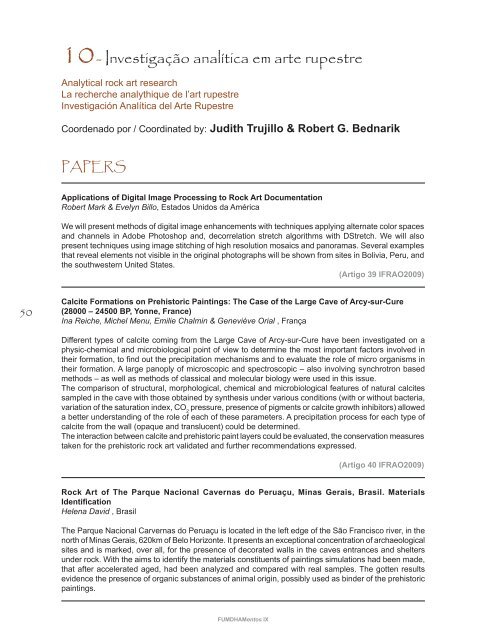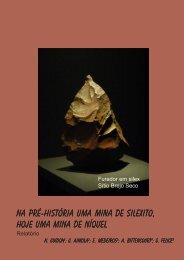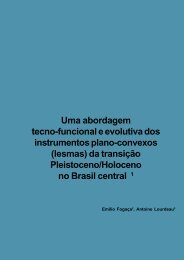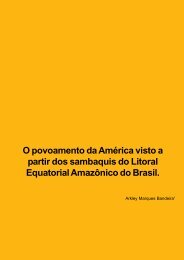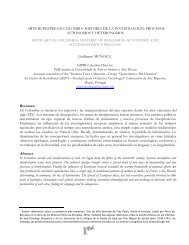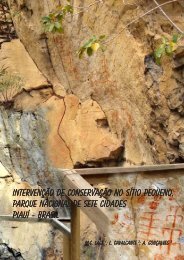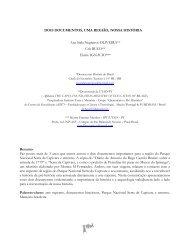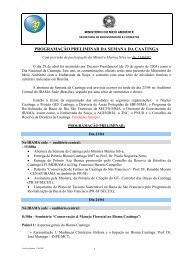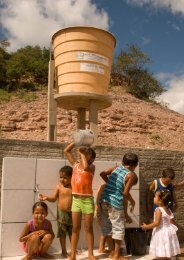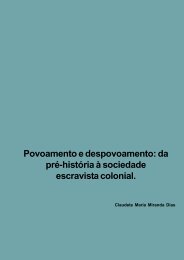Untitled - Fundação Museu do Homem Americano
Untitled - Fundação Museu do Homem Americano
Untitled - Fundação Museu do Homem Americano
You also want an ePaper? Increase the reach of your titles
YUMPU automatically turns print PDFs into web optimized ePapers that Google loves.
10 - Investigação analítica em arte rupestre<br />
Analytical rock art research<br />
La recherche analythique de l’art rupestre<br />
Investigación Analítica del Arte Rupestre<br />
Coordena<strong>do</strong> por / Coordinated by: Judith Trujillo & Robert G. Bednarik<br />
PAPERS<br />
Applications of Digital Image Processing to Rock Art Documentation<br />
Robert Mark & Evelyn Billo, Esta<strong>do</strong>s Uni<strong>do</strong>s da América<br />
We will present methods of digital image enhancements with techniques applying alternate color spaces<br />
and channels in A<strong>do</strong>be Photoshop and, decorrelation stretch algorithms with DStretch. We will also<br />
present techniques using image stitching of high resolution mosaics and panoramas. Several examples<br />
that reveal elements not visible in the original photographs will be shown from sites in Bolivia, Peru, and<br />
the southwestern United States.<br />
(Artigo 39 IFRAO2009)<br />
50<br />
Calcite Formations on Prehistoric Paintings: The Case of the Large Cave of Arcy-sur-Cure<br />
(28000 – 24500 BP, Yonne, France)<br />
Ina Reiche, Michel Menu, Emilie Chalmin & Geneviève Orial , França<br />
Different types of calcite coming from the Large Cave of Arcy-sur-Cure have been investigated on a<br />
physic-chemical and microbiological point of view to determine the most important factors involved in<br />
their formation, to find out the precipitation mechanisms and to evaluate the role of micro organisms in<br />
their formation. A large panoply of microscopic and spectroscopic – also involving synchrotron based<br />
methods – as well as methods of classical and molecular biology were used in this issue.<br />
The comparison of structural, morphological, chemical and microbiological features of natural calcites<br />
sampled in the cave with those obtained by synthesis under various conditions (with or without bacteria,<br />
variation of the saturation index, CO 2<br />
pressure, presence of pigments or calcite growth inhibitors) allowed<br />
a better understanding of the role of each of these parameters. A precipitation process for each type of<br />
calcite from the wall (opaque and translucent) could be determined.<br />
The interaction between calcite and prehistoric paint layers could be evaluated, the conservation measures<br />
taken for the prehistoric rock art validated and further recommendations expressed.<br />
(Artigo 40 IFRAO2009)<br />
Rock Art of The Parque Nacional Cavernas <strong>do</strong> Peruaçu, Minas Gerais, Brasil. Materials<br />
Identification<br />
Helena David , Brasil<br />
The Parque Nacional Carvernas <strong>do</strong> Peruaçu is located in the left edge of the São Francisco river, in the<br />
north of Minas Gerais, 620km of Belo Horizonte. It presents an exceptional concentration of archaeological<br />
sites and is marked, over all, for the presence of decorated walls in the caves entrances and shelters<br />
under rock. With the aims to identify the materials constituents of paintings simulations had been made,<br />
that after accelerated aged, had been analyzed and compared with real samples. The gotten results<br />
evidence the presence of organic substances of animal origin, possibly used as binder of the prehistoric<br />
paintings.<br />
FUMDHAMentos IX


